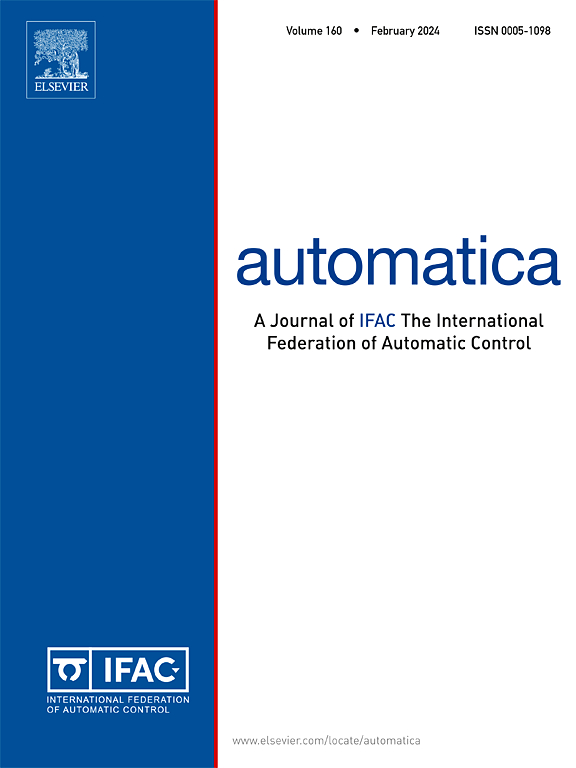Continuous safety-critical control of Euler–Lagrange systems subject to multiple obstacles and velocity constraints
IF 5.9
2区 计算机科学
Q1 AUTOMATION & CONTROL SYSTEMS
引用次数: 0
Abstract
This paper studies the safety-critical control problem for Euler–Lagrange (EL) systems subject to multiple ball obstacles and velocity constraints. A key strategy is to exploit the underlying cascade structure of EL systems to design a new safety-critical controller featuring an inner–outer-loop structure. In particular, the outer-loop control law is developed based on quadratic programming (QP) to avoid ball obstacles and generate velocity reference signals fulfilling the velocity limitation. Taking full advantage of the energy conservation property, a nonlinear velocity-tracking control law is designed to form the inner loop. One major difficulty is caused by the possible non-Lipschitz continuity of the standard QP algorithm when there are multiple constraints. To solve this problem, we propose a new feasible-set reshaping technique such that the refined QP algorithm with the reshaped feasible set admits a Lipschitz continuity property. Additionally, inspired by small-gain analysis, we construct a max-type Lyapunov-like function to integrate the safety constraints and the velocity-tracking error, and prove the achievement of the safety-critical control objective. The effectiveness of the proposed design is validated through numerical simulations and experiments on a 2-link planar manipulator.
多障碍物和速度约束下欧拉-拉格朗日系统的连续安全临界控制
研究了具有多球障碍物和速度约束的欧拉-拉格朗日系统的安全临界控制问题。一个关键的策略是利用EL系统的底层级联结构来设计一种具有内外环结构的新型安全关键控制器。特别提出了基于二次规划(QP)的外环控制律,以避开球障碍物并生成满足速度限制的速度参考信号。充分利用系统的能量守恒特性,设计了非线性速度跟踪控制律构成内回路。当存在多个约束时,标准QP算法可能存在非lipschitz连续性,这是一个主要的困难。为了解决这一问题,我们提出了一种新的可行集重构技术,使得具有重构可行集的改进QP算法具有Lipschitz连续性。此外,受小增益分析的启发,我们构造了一个极大型lyapunov函数来整合安全约束和速度跟踪误差,并证明了安全关键控制目标的实现。通过两连杆平面机械臂的数值仿真和实验验证了该设计的有效性。
本文章由计算机程序翻译,如有差异,请以英文原文为准。
求助全文
约1分钟内获得全文
求助全文
来源期刊

Automatica
工程技术-工程:电子与电气
CiteScore
10.70
自引率
7.80%
发文量
617
审稿时长
5 months
期刊介绍:
Automatica is a leading archival publication in the field of systems and control. The field encompasses today a broad set of areas and topics, and is thriving not only within itself but also in terms of its impact on other fields, such as communications, computers, biology, energy and economics. Since its inception in 1963, Automatica has kept abreast with the evolution of the field over the years, and has emerged as a leading publication driving the trends in the field.
After being founded in 1963, Automatica became a journal of the International Federation of Automatic Control (IFAC) in 1969. It features a characteristic blend of theoretical and applied papers of archival, lasting value, reporting cutting edge research results by authors across the globe. It features articles in distinct categories, including regular, brief and survey papers, technical communiqués, correspondence items, as well as reviews on published books of interest to the readership. It occasionally publishes special issues on emerging new topics or established mature topics of interest to a broad audience.
Automatica solicits original high-quality contributions in all the categories listed above, and in all areas of systems and control interpreted in a broad sense and evolving constantly. They may be submitted directly to a subject editor or to the Editor-in-Chief if not sure about the subject area. Editorial procedures in place assure careful, fair, and prompt handling of all submitted articles. Accepted papers appear in the journal in the shortest time feasible given production time constraints.
 求助内容:
求助内容: 应助结果提醒方式:
应助结果提醒方式:


